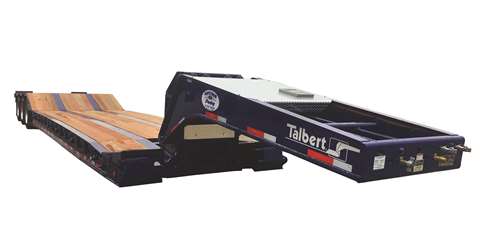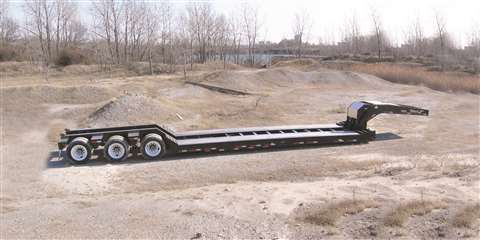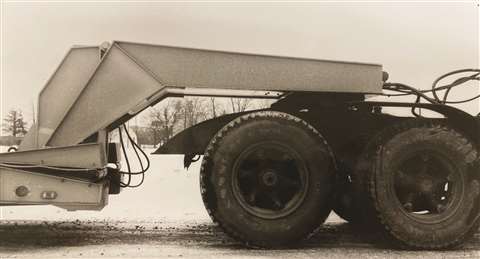Celebrating the 75th anniversary of the removeable gooseneck trailer
03 January 2023
The removable gooseneck trailer is a mainstay in the business of heavy hauling. In 2022, this ubiquitous technology celebrated its 75th anniversary.
 Troy Geisler, Vice President of Sales and Marketing Talbert Manufacturing
Troy Geisler, Vice President of Sales and Marketing Talbert Manufacturing
“Austin Talbert conceived and patented the mechanical removable gooseneck technology in 1947 to address safety concerns from previous designs in which the neck was permanently fixed to the deck of the trailer,” said Troy Geisler, vice president of sales and marketing for Talbert Manufacturing. “The new design addressed the troubling number of injuries, deaths and equipment damages that occurred when loading and unloading equipment with non-removable models. Previously, trailers sat upward of 50 inches off the ground while loading in the rear, side-loading or overhead loading. The loading and unloading angle could be so steep that the tipping point was reached without warning.”
Geisler explained that the removable gooseneck lowered the trailer deck for a safer and more stable loading angle.
“This is addressed through both the hydraulic and the mechanical removable goosenecks,” he said. “That focus on safety continues to this day. Our trailers’ load capacities are rated at half the deck length, and we build to the industry’s highest safety factors. Since its inception, Talbert has designed two different removable gooseneck trailers: hydraulic detachable gooseneck trailers and mechanical detachable gooseneck trailers.”
Talbert has been building world-class heavy-haul and specialized trailers since 1938, Geisler said.
“We work with customers in the commercial, industrial, military and government sectors,” said Geisler. “For more than seven decades, we’ve provided innovative and durable transportation solutions for North America. We continue to build a solid reputation for quality and carrying the most challenging loads.”
Trailer career path
Starting his 19th year in the trailer industry and his tenth year at Talbert Manufacturing, Geisler started his career path in trailers in 2004 at Vanguard National Trailer Corporation, a dry van manufacturer. After moving to Illinois, he started working for ILoca Services, a trailer dealership in Aurora, IL. The company represented a wide array of trailer manufacturers, including Talbert. He left ILoca Services in 2013 to join Talbert as a regional sales manager before being promoted to his current role.
 The Talbert Manufacturing long-haul experts celebrate the 75th anniversary of the introduction of the non-ground bearing hydraulic detachable gooseneck trailer, which greatly enhanced safe trailer operations.
The Talbert Manufacturing long-haul experts celebrate the 75th anniversary of the introduction of the non-ground bearing hydraulic detachable gooseneck trailer, which greatly enhanced safe trailer operations.
In November 2022, ACT learned about the 75th anniversary of the removable gooseneck. We reached out to Geisler about this momentous occasion, and to discuss this milestone and trailer technologies in general.
Geisler knows the trailer market inside out, and he’s an advocate for his company and its customers.
What does the ‘non-ground bearing’ aspect of the gooseneck trailer mean?
A non-ground bearing gooseneck trailer uses gooseneck hydraulics to lift the trailer bed so the trailer can disconnect from or connect to the neck. The main benefit of the design is that the gooseneck has no contact with the ground, improving safety. These trailers are more flexible and versatile than their ground-bearing counterparts with more ride height adjustment, a narrower neck and the ability to connect and disconnect on uneven surfaces.
Before the innovation of the non-ground bearing technology, jacks were known as one method operators used to raise and lower trailers. Operators carried house jacks with them and placed them on each side of the rear deck of the trailer. These jacks raised and lowered the deck for loading and unloading. This system made the entire operation more dangerous with less ability to predict where the tipping point might be reached and was made even more unsafe in soft ground conditions.
In 1970, Talbert Manufacturing launched a new, patented hydraulic design called the Hydroneck. What does this bring to the table?
The Hydroneck creates additional customization options for balancing weight distribution when it comes to the removable gooseneck trailers with the addition of shims to help balance and distribute loads without relying on preset weight or height limits. This design can be featured on both the double drop series and the lowboy series.
 The non-ground bearing hydraulic detachable gooseneck trailers have undergone a series of design adjustments since their inception in 1962, including the introduction of the Hydroneck and ratchet neck trailer designs.
The non-ground bearing hydraulic detachable gooseneck trailers have undergone a series of design adjustments since their inception in 1962, including the introduction of the Hydroneck and ratchet neck trailer designs.
In 1989, Talbert designed and patented the mechanical removable gooseneck trailer. What are the attributes of this design?
The mechanical gooseneck trailer is lighter than the hydraulic trailer and doesn’t require hydraulics for positioning. The mechanical attachment style is typically used for double-drop trailers. The mechanical gooseneck trailer utilizes front rollers and truck ramps to connect and disconnect the trailer from the truck. The mechanical design is usually preferred by longer-distance trucking companies when the load will be on the truck for several days and unloading occurs on smooth, flat surfaces.
How many companies produce gooseneck trailers? How many are in use in the world today? North America?
There are over 80 manufacturers of gooseneck trailers in North America that serve an array of different needs and applications. I encourage buyers to do their homework because not all trailers are engineered and built to the same standards. Since the inception of the removable gooseneck trailer, Talbert Manufacturing has built over 25,000 models with thousands of custom units. Around 92 percent of Talbert trailers built since 1985 are still on the road today.
My advice for those needing a removable gooseneck trailer is simple: Reach out to the users in the surrounding area to better educate yourself on the best investment for your application. Do your best to anticipate equipment needs for your business for as long as you plan to operate the trailer. Heavier, wider, longer or taller loads require different trailer designs. Knowing what loads and where you plan to haul greatly impacts the design you need.
How do you characterize the trailer business at this juncture?
The trailer business as a whole is currently being challenged through labor and part shortages along with massive spikes in material and shipping costs. We’re focusing on open communication when it comes to our dealers and customers, and everyone is on some sort of allocation at this time. Once our current normal fades, and these massive daily challenges erode, we will come out better and stronger than before. 2023 won’t be without its challenges, but we’re cautiously optimistic.

You’ve been in the trailer business for many years. What keeps you engaged?
I thoroughly enjoy the fact that we take part in building America. We take the time to listen to customer needs as they evolve to provide a trailer design solution to deliver their product/equipment/goods from point A to B to Z. All the while, safety and dependability remain our biggest priority.
Our customer base consists of hardworking, innovative individuals who make the impossible possible. In their business, there’s no time to sit back on the sidelines. They continue to show up day in and day out. We do too.
STAY CONNECTED


Receive the information you need when you need it through our world-leading magazines, newsletters and daily briefings.



